A get-home bag, or GHB, is a cousin to a bug-out bag. Where a BOB is designed to help get you away from home and hopefully to your bug-out location, a GHB is a bag designed to help you get home if disaster strikes while you’re away from home.
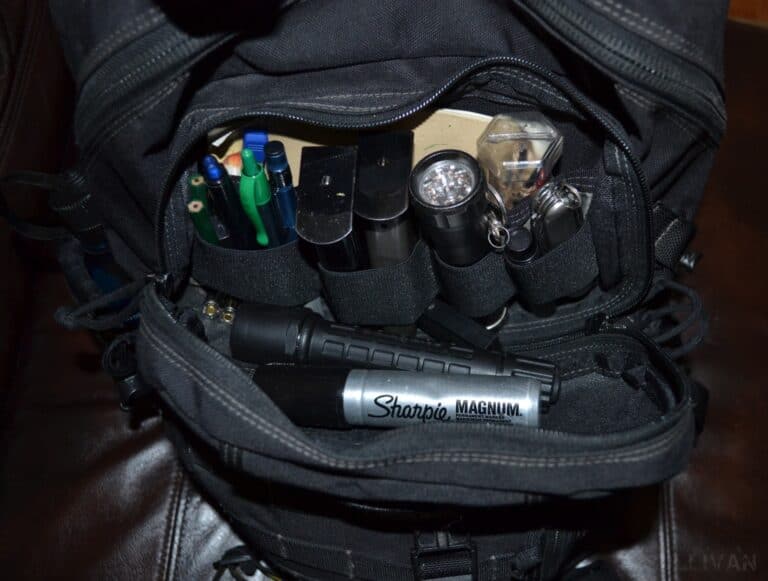
A get-home bag is a step forward in prepping to make sure you’re covered in a wider array of disaster scenarios you might face. It’s the next logical piece of kit to add after your EDC and BOB.
Here’s the thing, we all have in our heads an idea of how things will happen. It’s Sunday afternoon, and you’re at home with your family, watching another episode of your favorite show.
All of the sudden, bam, an earthquake strikes, so you rush to get your bug-out bag, load the car with as many additional supplies as you can and get the heck out of there.
But what are the odds of you actually being home when it happens? Not particularly high, unless you spend most of your time at home.
And what about your spouse and kids? They might be in school and your spouse might be at work or running errands.
So given the odds, it makes perfect sense to talk about how to build a rock-solid get-home bag for you and each of your family members, which could assist you in all sorts of disastrous events big and small, natural disasters or man-made catastrophes.
The best part is, even if you won’t get to use this kit to actually get home, you’ll still have yet another bag packed and ready to go. A get-home bag is an excellent way to pack and have redundant survival items.
Table of Contents
The Bag
Since the idea of a GHB is to have it near you at all times when you’re away from home, you can’t go for a bag so large and unwieldy that it draws too much attention.
People will wonder what you’re up to if you are carrying around an expedition pack in an office setting.
Getting labeled as a prepper can also have mild to severe social consequences depending on the prevailing culture and societal norms where you live.
A good GHB bag should ideally:
- be small and lightweight (remember, this isn’t a full-size bug-out bag); ideally, it shouldn’t weigh more than 20 lbs (that’s 9 kgs), even less if we’re talking about children’s get-home bags
- blend in with the surroundings, work environment, the way you dress, etc.
- should also fit some of your EDC items (otherwise people will wonder why you carry it around with you and never open it)
The following types of bags can work as get-home bags:
✅ Laptop bag – An edc laptop bag is an excellent choice for tech-savvy professionals who constantly rely on a computer or other device. Larger ones can carry a fair amount of extra equipment in addition to everything you might need for a usual trip to the office.
If you carry a smaller, leaner laptop bag then your extra space will be sharply curtailed. The biggest disadvantage of a laptop bag is shared by most other bags that are not backpacks; it will have only a shoulder strap and a handle to help you carry it.
✅ Purse – A large purse is an obvious choice for toting equipment if you are a lady. As a rule, you will always have it with you, always have it pre-packed with things you need before leaving the house, and will usually have plenty of room to spare if you take out the majority of the stuff you don’t need.
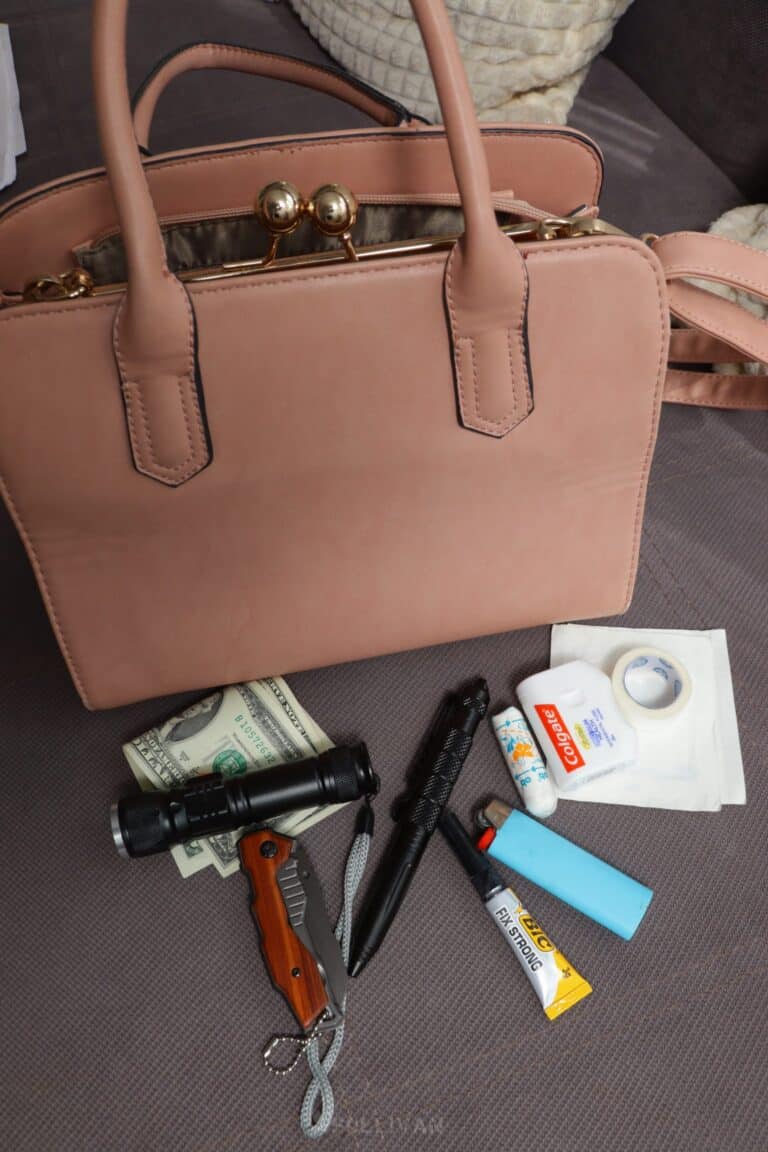
Purses typically have a reasonably sturdy shoulder strap and might even have two depending on the type of purse. purses do have some shortcomings though.
Usually, they have very little in the way of organization on the inside and they definitely are not as stable or reliable as a good backpack. Also, keep in mind that a woman’s purse is often the very target of an attack.
✅ Messenger bag (black, brown, dark blue – it’ll make you look pretty stylish, too!) – Messenger bags are an iconic and increasingly popular luggage option for city dwellers or preppers who just want to assume a more urbane appearance instead of carrying a backpack.
Messenger bags offer plenty of capacity, a public space, and an office-friendly appearance, and often have plenty to offer you when it comes to storage and organization.
The biggest drawback with messenger bags is it they typically cannot be loaded heavily, much like purses, and are typically carried with a crossbody strap I know a few have an accessory waist belt that can offer more stability. much like purses, messenger bags are often the targets of an attack.
✅ Small or medium backpack – For a get-home bag it is awfully difficult to beat a traditional backpack of any kind.
A backpack gives you the capacity, stability and a sturdy has to withstand hard use and challenging movement in the middle of a crisis situation when the distance traveled and appropriate speed could spell the difference between life and death.
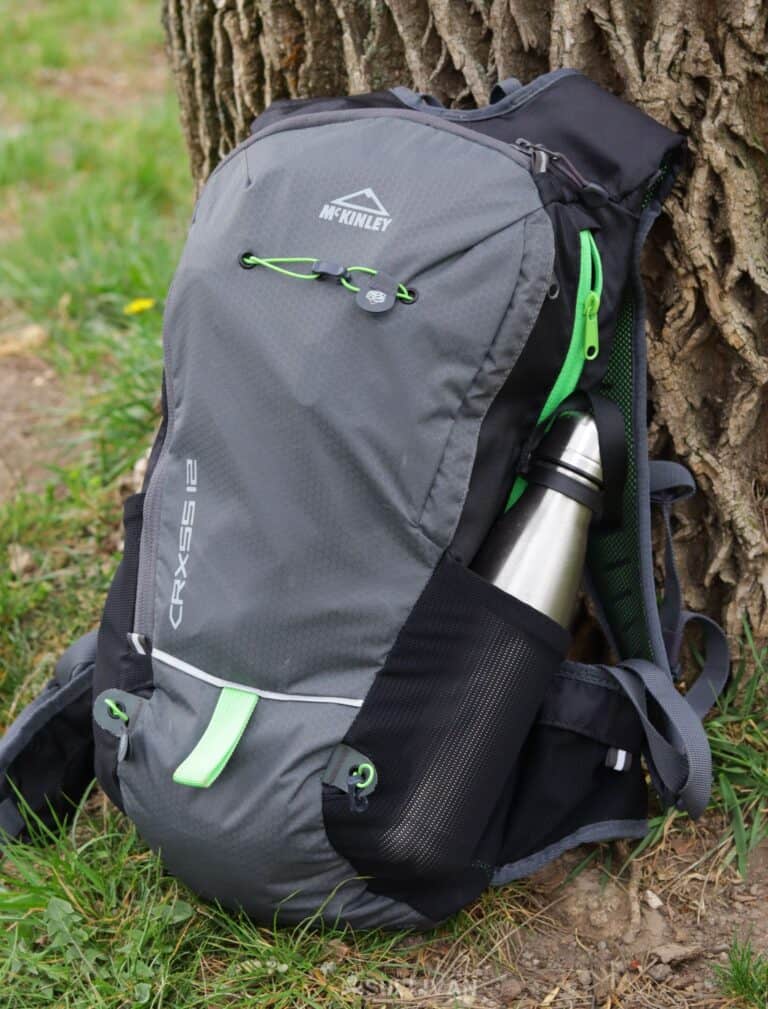
Ideally, you want your backpack to match your environment so it looks at home. That means you will be able to keep it with you more often without raising suspicion. mark
Now, the biggest disadvantage of a backpack is that there are some settings they just don’t belong in, like many white-collar jobs and certain service industries. However, there are plenty of sturdy backpacks you can get.
✅ A duffle / gym bag – For sure capacity and a minimum of fuss, a gym bag or duffle bag is an okay option. You can cram whatever you need into one and reasonably expect it to hold up if it is high quality.
Like many of the alternate bags on this list, the biggest shortcoming with gym bags or duffle bags is that they rarely feature anything in the way of internal organization, and oftentimes only have a single shoulder strap, though some will let you wear them on your back like a backpack, but a very floppy one.
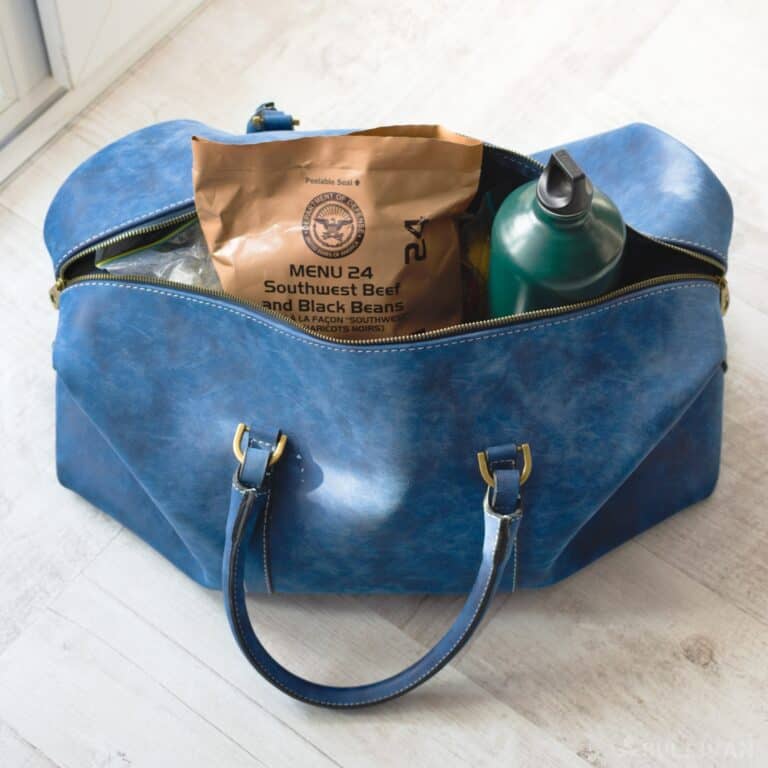
Note that these bags stick out more than most if you’re anywhere but at the gym or at a sporting event. Nevertheless, they can work in urban environments where people are used to them…
Take care, and consider avoiding bags and backpacks with the following features:
- ❌ Overtly tactical or military appearance – recall that your GHB may accompany you as you go to your job/appointment/whatever. Tactical backpacks can be very conspicuous in some settings.
- ❌ Bright colors or loud patterns – same as above for different reasons. If you are in a conservative dress setting, your neon orange and silver-tan pack will be noticeable.
- ❌ Designer or very expensive packs – fashion packs and luggage, while often exquisitely crafted, usually will not stand up to the same level of wear, tear, and outright abuse as their less-expensive and plebian but purpose-built cousins. If you are going to choose a fancy pack for your GHB, make sure you can test it thoroughly before declaring it good.
- ❌ Too-Large Packs – Once again, you want to blend in and hopefully move fast, not look like you’re going on safari in Africa. The exceptions are if you live in a rural area, if you travel a lot, or if you usually drive a car – although keep in mind that a GHB should ideally go where you go, not left in your car.
Recommendations
Disclosure: This post has links to 3rd party websites, so I may get a commission if you buy through those links. Survival Sullivan is a participant in the Amazon Services LLC Associates Program. As an Amazon Associate, I earn from qualifying purchases. See my full disclosure for more.
Based on our above criteria, here is a selection of backpacks and other bags that would make fine get-home bags.
- the Vertx EDC Commuter Bag
- 5.11 COVRT18 Backpack
- Fieldline Alpha OPS Daypack (this one is more tactical, MOLLE compatible, and whatnot, but it looks average)
- AmazonBasics 15.6-Inch Laptop and Tablet Bag
- The Bobby anti-theft backpack – I have one of these and they’re great. It’s impossible for a thief to open it without you feeling it.
- the LA Police Gear Atlas 72H Backpack
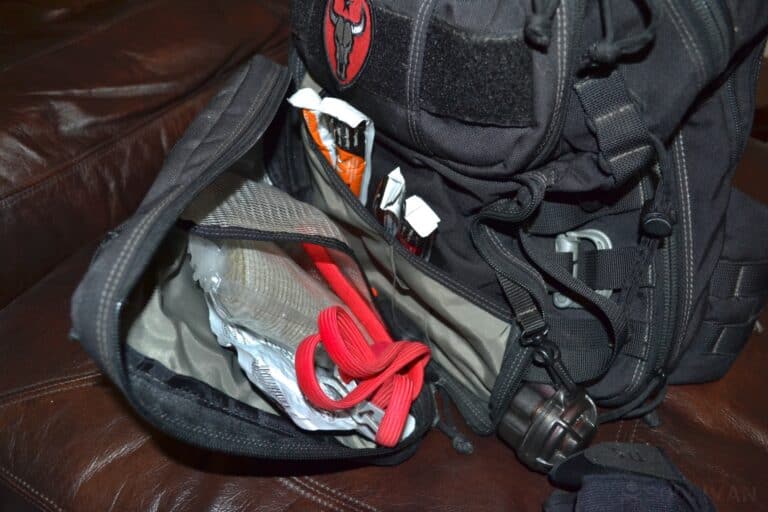
Typical Get Home Bag Contents
For the list below, I’m going to give you each item in order of how important it is for your GHB.
I’ll leave it up to you to decide what to ultimately pack but please keep in mind that a get-home bag should trend toward small size and as lightweight as possible.
You don’t want to overburden yourself when you are facing a long and fast march home.
The way you decide how much to pack is by knowing the nominal distance between you and home. The farther you tend to travel from home for work or whatever, the more stuff you need.
Also, consider the climate you live in, the season, and whether you’re in an urban, suburban, or rural environment.
Water Filter
In most situations like a traffic jam or snowstorm, you should be able to get home within a relatively short period of time, probably less than 5 hours.
A person can go for as many as 3 days without water. But dehydration can set in quickly after several hours in a hot car or if you have to walk to get home.
Lifestraws and Sawyer Minis are the obvious choices here. Since we’re dealing with short get-home scenarios, just one will do.
However, you’ll need these for your bug-out bag, for your family members, or just to have around for a really long SHTF disaster.
You can throw in a couple of water purification tablets, and you’re good on the water front.
Water Bottle
Water is an essential need no matter what you’re surviving, however, this is probably going to be pretty heavy. Either get a smaller water bottle or fill it halfway.
Folding Knife
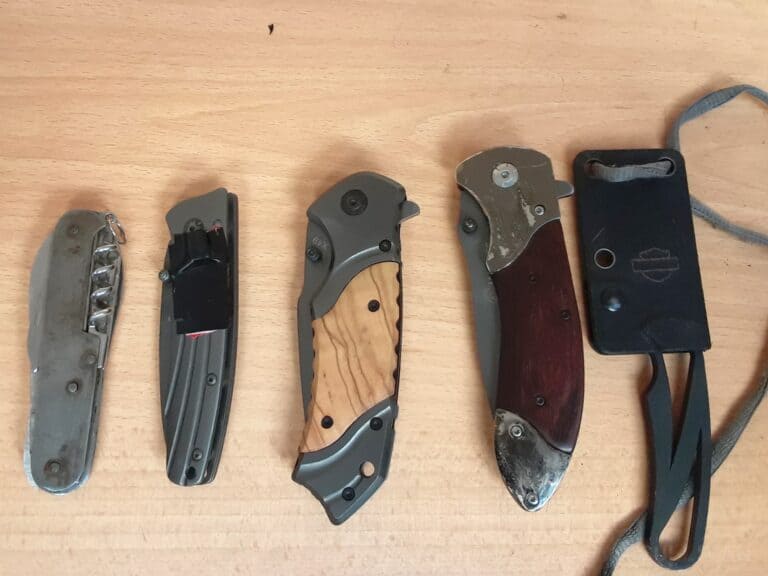
Folders typically take up less space than fixed-blade knives, and they should be more than enough for get-home scenarios.
Hat or a Cap
Get a hat that will stay safely on your head as you’re running home. A baseball cap, maybe, or a winter hat if it’s that time of the year.
A baseball cap will also keep the sun out of your eyes and head, protecting you from a possible heat stroke, and sunburns.
Compact Flashlight
Lucky for us, there’s no shortage of small, lightweight flashlights.
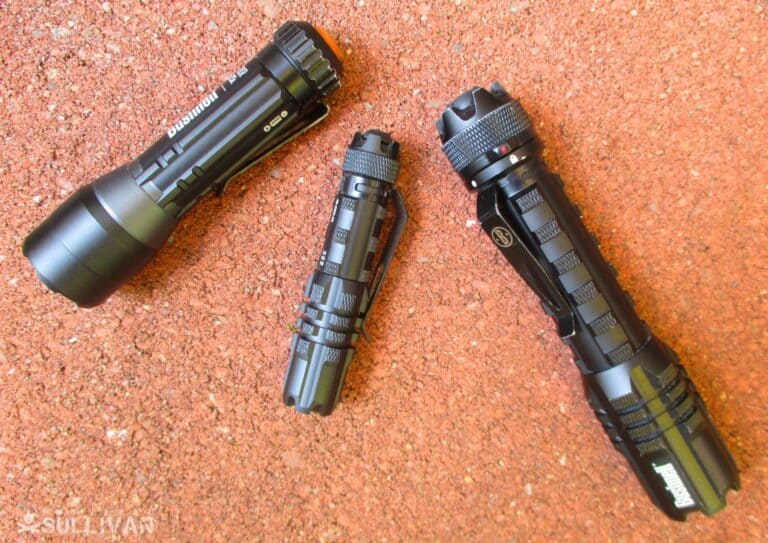
In an emergency, you probably won’t use your phone to light your way because you might need to talk on it, use the maps/GPS navigation, or do something else with it.
Get a compact hand-crank flashlight because then you won’t have to worry about dead batteries.
Map of the Area
This isn’t just for route planning, consider that you may have to take a route you didn’t previously consider.
There’s no telling how things will unfold. Regardless, there are some things you’ll want to mark on it, such as:
- all of the possible routes (by car and by foot) to get home
- location of ATMs in-between home and work
- location of vending machines
- one way streets
- …and more.
Be sure to laminate your map, or at least store it in a Ziploc bag along with other items non-resistant to water.
Small First Aid Kit
Small first-aid kits like this one are lightweight and will cover a wide variety of emergencies.
If you want, you can make one yourself to save some $$$ and familiarize yourself with its contents.
If you’re not sure what to pack be on the look for things like:
- an assortment of bandages
- Ibuprofen
- disposable vinyl gloves
- a few Ibuprofen tablets
- scissors
- moleskin (for blisters)
- …and so on.
Bandana
This cheap, multi-use item could prove extremely useful in a get-home situation. Here are just a few ideas that come to mind:
- use it to tie your hair so it doesn’t get in the way while you’re busy surviving
- use it as a sling
- use it as an eye patch if you get an eye injury
- tie it around your neck to keep you warm
- and on, and on and on.
Respirator Mask
Whether you’re stuck in a riot and are trying to avoid tear gas, whether you’re trying to move through a smoky area (think wildfires and the dust that 9/11 survivors had to face), you’re going to need more than a bandanna to keep around your mouth.
An N95 respirator should do the job, but if you want even more protection, you can opt for an N99 respirator mask, which filters smaller-sized particles and, although more expensive, it’s not something most of us can’t afford.
Duct Tape
Like a bandanna, duct tape has a million and one uses. It’s a must in every survival bag, be it a bug-out bag, inch bag, or get-home bag. If you’re going to get something strong, you can try Gorilla tape.
If you want to save some space, how about you pack in your GHB a roll that’s already been halfway used? You probably won’t need that much duct tape, anyway.
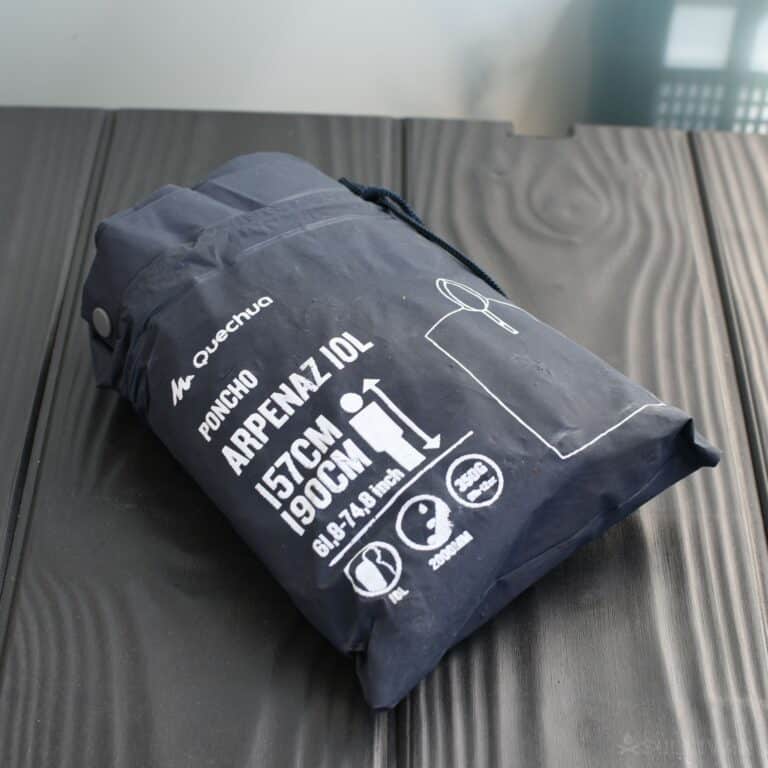
Tarp or Poncho
You probably won’t have time to sleep, but who knows, maybe your get-home journey will span several days.
Besides, a tarp or a poncho will have other uses too, such as collecting rainwater, keeping you warm as you’re moving, as makeshift bags.
I would recommend you get the poncho over the tarp. Although it’s smaller, you can wear it, and it should be able to keep you warmer and protect you from rain and wind. How about this one?
Prepaid Calling Card
If one network is down, consider using another one to call your loved ones to know their whereabouts.
Lightweight Food
In most cases, you’ll be on the road for several hours at the most. The basic recommendation for a get home bag goes as far as food is 3 days’ worth.
If for some reason you can’t get home quickly you can stretch 3 days’ supply twice as long if needed. Your main concern for food to keep in a get-home bag should be maintaining your energy levels.
Even if the journey home is a relatively short one, the stress and calories you burn to get home could leave you feeling lethargic.
Pack some lightweight food such as a couple of energy or protein bars, or a small bag of nuts. A little chocolate never hurts and it can boost morale when things are tough.
Gloves
Heavy-duty work gloves could prove extremely useful in situations such as having to move heavy objects, climb trees and other things, jump fences, turn rusty faucets and valves off, and so on.
Cash
There’s a chance that you won’t be able to use your phone or credit cards to pay in an emergency, particularly in one that’s large-scale.
Having some cash could buy you a lot of things, such as your freedom when facing thugs or rioters, a ride home, or some badly needed supplies that didn’t fit your get-home bag.
Multitool
Just like flashlights, you can get compact multitools that could help you solve some technical problems that may arise.
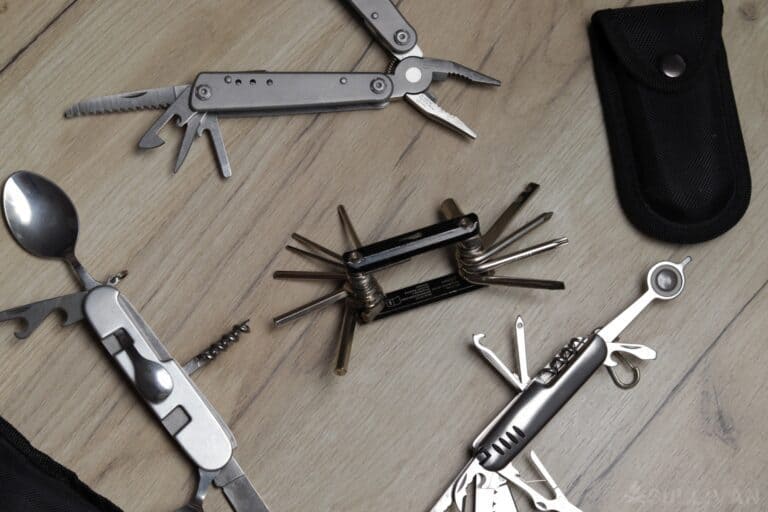
These little things have over a dozen mini-tools, from pliers and a screwdriver to a hook remover and even a folding saw!
Of course, you can use them in day-to-day life. You will end up needing a bottle or can opener, or screwdriver.
Lighters
I doubt you’ll ever have to start a fire and make shelter in a get-home situation, but you never know what you might use a lighter for.
Maybe to light a cigarette? Bics are cheap and lightweight, so it’s worth throwing a couple in your GHB.
Emergency Blanket
Useful particularly if you have a tarp instead of a poncho.
These will help to trap body heat, so you don’t get hypothermia. They are small and lightweight.
Pepper Spray
Every get-home bag should have a lightweight alternative self-defense weapon. Pepper spray is one such weapon.
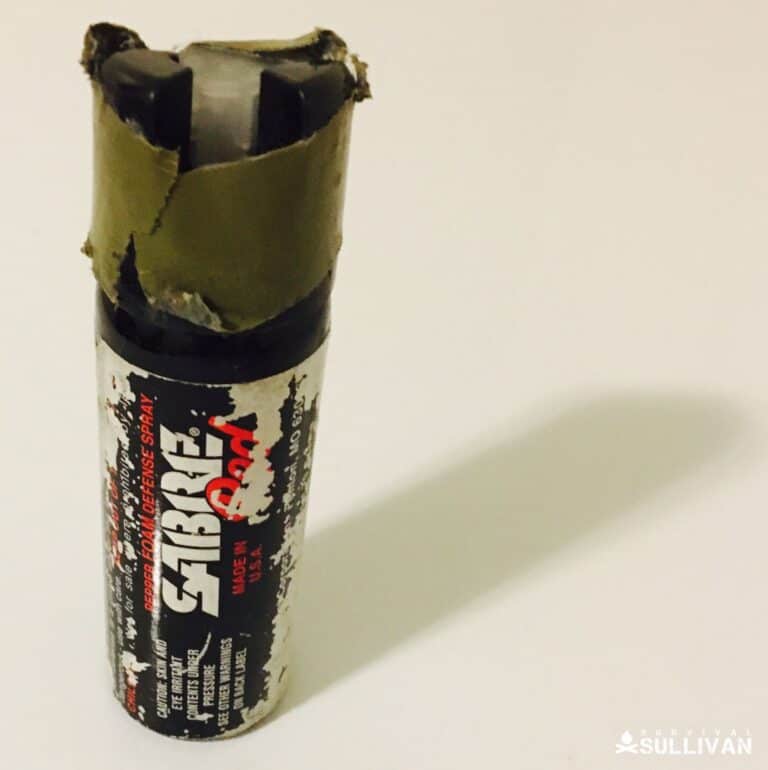
You may want to keep it concealed in an exterior pocket of your bag, for quick access.
You never know when you get attacked, or when a spontaneous fight occurs next to you, and you need to create yourself a quick opportunity to get out of there ASAP. A good pepper spray will also be effective against any dogs you might encounter.
Don’t forget to replace your pepper spray after it expires, and to learn and practice how to use it effectively.
Sunglasses
Get a pair that has both UVA and UVB protection to keep your eyes safe.
Paracord
Another multi-use survival item. You just cannot have a survival kit without cordage.
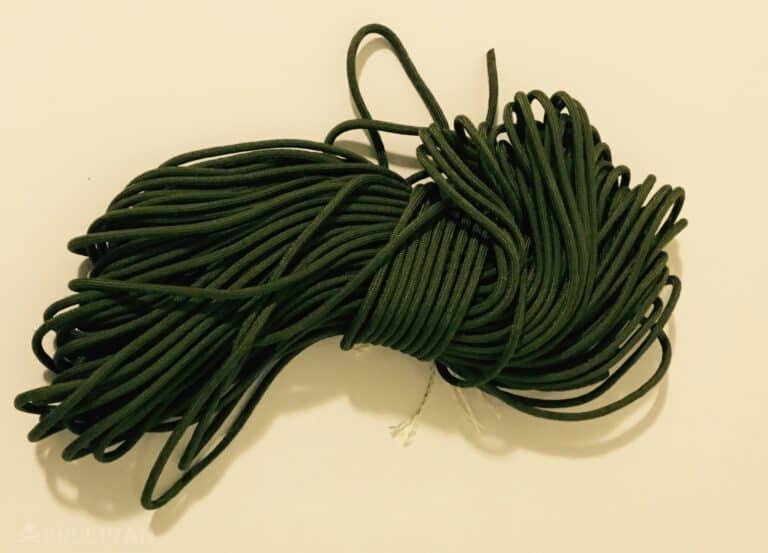
Since we’re talking about a small GHB, you probably won’t need more than 25 feet of Paracord (that’s around 8 meters).
Extra Pair of Socks
It’s possible that you’ll get wet for whatever reason, so changing your socks could spare you a lot of discomfort. Keep a pair in your bag because it won’t take up much space, and it is super light.
Extra Shirt
Why throw away an old t-shirt, even if it has a few holes in it, when you can pack it neatly in your GHB? You never know when you might get wet, and having a spare will save you a lot of discomfort.
Spare Glasses
If you wear vision glasses, it’s likely that you’ll break or lose the pair that you’re wearing. Keep spares in a puncture-proof container, because losing your eyesight in an emergency is one of the last things you’ll want.
Rural folks or anyone who typically travels country / gravel roads may also want to pack a pair of safety glasses – very good against dust and debris.
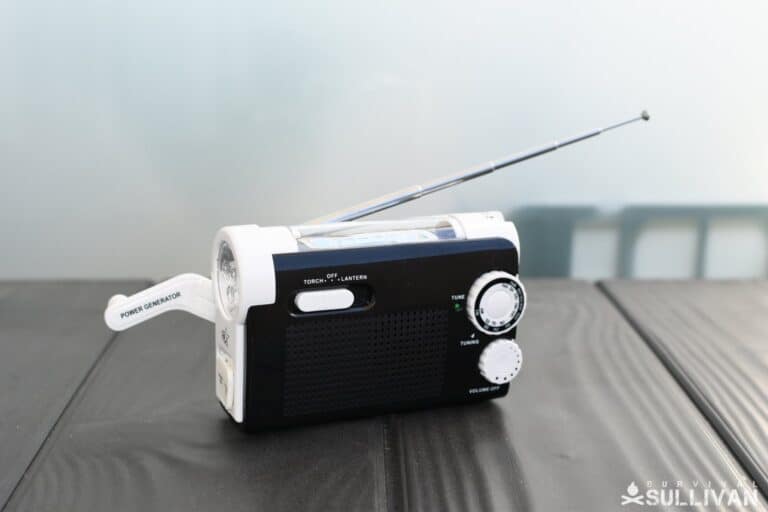
Small Emergency Radio
Learning what’s going on around you in an emergency is paramount to making the right decisions.
A compact AM/FM NOAA emergency radio will do a lot more than tell you the latest news. Some are hand crank, (so you don’t have to worry about batteries), and can even help you charge your phone.
Emergency Whistle
Will you need a whistle in a get-home scenario? Maybe. But it doesn’t hurt to have one, particularly since they’re dirt cheap.
Small Hygiene Kit…
…consisting of a small toothbrush, toothpaste, a small towel, wet wipes, plus anything else you can think of.
Sunscreen
If the journey will take a few hours or more, you’ll want your skin protected. You don’t want to get a rash or sunburn.
Compass
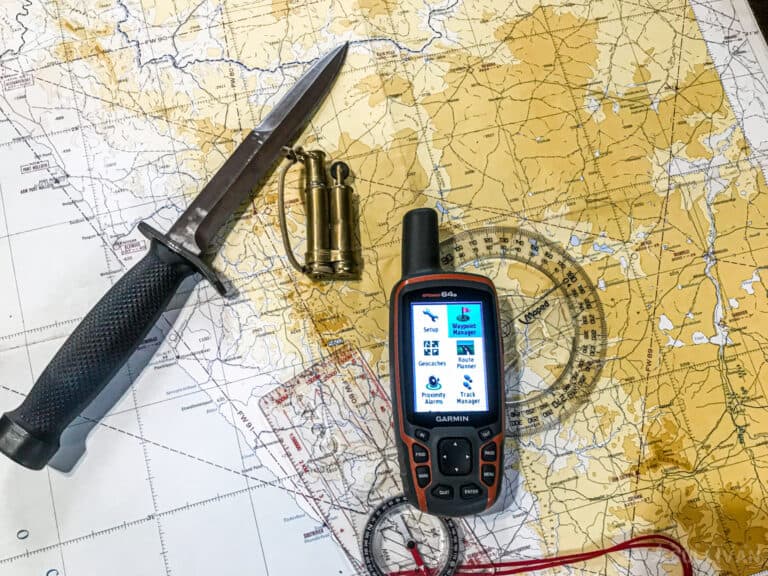
A good compass is useless without the knowledge to use it.
But if you do know how to use it, it won’t matter if your phone’s GPS doesn’t work – you’ll still find your way home.
Signaling Mirror
People will assume you have it so you can check yourself out from time to time, but you’ll know better. You can use it to signal someone or to grab someone’s attention from a distance.
Insect Repellent Spray
If you don’t want any mosquitoes annoying you while you’re trying to survive, pack some insect-repellent spray.
Extra Batteries…
…for the flashlight, emergency radio, or anything else in your kit that runs on batteries.
Waterproof Matches
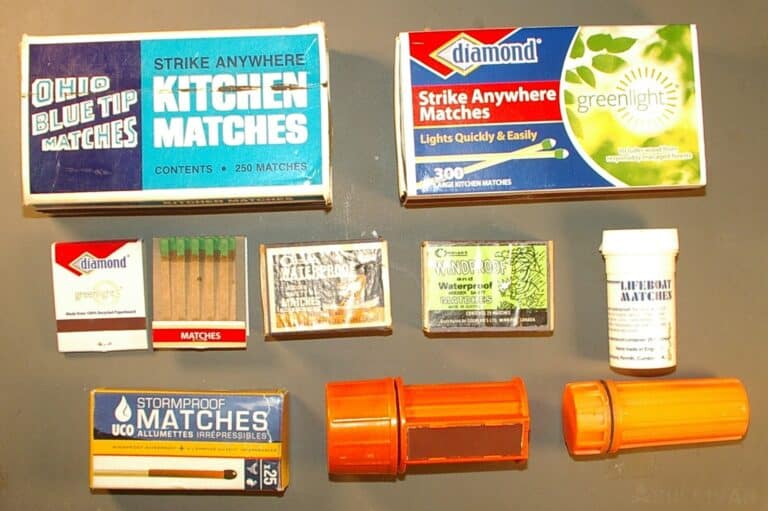
These will complement your lighters. Fire is one of the most basic survival needs, so it’s good to have a backup.
Always carry at least two methods for fire starting as well as something for tinder in case there isn’t any readily available.
You may not need them if you get home quickly but why take a chance?
Respiratory Mask
A solid respiratory mask that is at least an N-95 can not only protect you from inhaling dust and debris, it may protect others from any viral infections you may have.
Power Bank / External Battery
Even if you get a solar charger or one of those hand-crank chargers you see on some emergency radios, you should still get an external battery. Make sure you keep it at least 50% charged at all times.
Toilet Paper
You just never know when an -ahem – an emergency could hit. Remember, your get home bag isn’t just for SHTF, it’s for everyday emergencies as well.
Headlamp
This is extremely useful because it will keep your hands free while you’re biking or running home.
Mosquito Netting
Will you need it? Well, maybe.
It never hurts to have some, you never know where you’ll end up, how long you’ll have to wait, and whether you’ll have to worry about mosquitoes or not.
You’ll be forgiven if you don’t add this one to your list, but it wouldn’t hurt you if you did.
Small Binoculars
These will allow you to see from afar, particularly if you’re unsure whether your house is safe to enter or to get close to. Even better, you could get a monocular because it’s smaller, lighter, and cheaper.
4-Way Sillcock Key
This will help you open most outside valves and faucets on pretty much all commercial buildings.
It’s a must for any city dweller because when you get home, one of the first things you might need to do is turn off those valves.
Paper and Pencil
You might have to write things down, obviously. There’s no point relying on your phone’s tiny keyboard (assuming your phone will be working).
Communication Devices
Landline phones, cell phones, and internet connections may all be down in a disaster. News broadcasts through AM/FM radio signals will keep you up to speed on what’s happening, how bad it is, and when it’s safe to come back into your home area.
Weather information will be important to prepare yourself for frigid temperatures or impending storms. It’s far better to know what to expect in advance than to suffer through a freezing night without having adequately prepared.
Walkie-talkies, handheld CB radios, NOAA emergency radios – ideally, your family members should each have one of these.
Of course, make sure they’re all tuned to the same frequency, and that you test the range. If you’re in an urban setting, it’s likely they won’t work for very long distances.
Additional Get Home Items
If you have a car that you drive every day this means you can probably stage your GHB in the trunk or other secured compartment (or at least out of sight from potential thieves) and potentially stash a few additional GHB goodies.
Below is a list of additional items you might consider storing in your vehicle alongside your GHB. Up to you which items you need most, of course.
- blanket
- a second water filter
- Hatchet (for vehicle extrication and B&E if needed.)
- chainsaw or an ax (in case the streets are blocked by fallen trees)
- pry (for opening doors and gates)
- advanced first-aid kit
- fixed-blade knife
- stainless steel water bottle
- collapsible cup
- chalk (useful in urban areas to write messages)
- Ziploc bags
- instant single-serving coffee packets (if you drink coffee, these will be a lifesaver and a great comfort drink)
- USB and mini USB charging cable
- Notepad and pencil or pen
- folded tin foil
- butane lighter
- foot powder
- zip ties
- scissors
- hiking boots
- hand sanitizer
- pop flares (for signaling)
- Pen flares
- sewing kit
- large trash bags
- lip balm (can be used as a fire starter)
- umbrella
- Close-quarters weapon: club, machete, etc. if hatchet is not carried
- everything your car would need to take you home safely no matter what the season or the circumstances (especially some extra fuel).
Keep in mind that if someone decides to break into your car, they can and will steal all your supplies. This means your gun, ammo and your credit card will be missing.
I sure hope you won’t write down the PIN code and leave it next to it (or somewhere else in your GHB)!
Packing Considerations
There are several things to consider when deciding what to pack in your GHB. Your locale (urban, suburban, rural), will play a part in how large your pack can be and not draw more than casual notice.
The nominal distance between your daily destination and home will also help determine both the size and loadout of your GHB.
Other factors to consider are your age, fitness level, and general constitution. A young, fit athlete can carry a heavier load farther and faster than someone who is out of shape or infirm.
Be sure to consider your health conditions or ailments, if any, and pack medicine and supplies to accommodate them accordingly.
The climate too requires accommodation. You must assume you will be heading home on foot for the entire journey.
What is the weather like in your locale in the current season? How about at night? You must pack clothing to prevent exposure from becoming a serious threat.
If you do not take your personally owned vehicle out every day, consider that you will not have any reasonably secure storage for sensitive items that you cannot bring into your workplace. Plan accordingly for packing guns and knives.
In addition, consider waterproofing and shock-proofing your most sensitive get-home bag items, by using Ziploc bags and plastic Tupperware containers.
Things like your socks, maps of the area, or toilet paper should all be stored in zipper bags.
Now, if you don’t want a full-sized GHB, but do want the peace of mind that you’ll have at least some survival items to help you get home, consider a minimalist get-home bag with fewer items that are cleverly hidden among your typical EDC.
Now that you have your GHB all assembled, this doesn’t mean you’re ready. The most important components in any preparedness plan aren’t items at all: they are your skills.
Without skills, you’re bound to make potentially lethal mistakes out in the wild. Keep your survival skills sharp and up to date. Practice fire-starting, shelter-building, and basic first aid well in advance.
Clear instructions on what to do in a catastrophe should be stowed inside your child’s backpack. Knowing they have needed supplies will help them to stay put until you can get to them.
Their backpacks should also contain a few EDC items, such as a flashlight, a mobile phone, and a wallet with $5 – $10 in it. Start teaching them basic survival skills early on.
You can have all the tools in the world, but if you don’t know how to use them, you may as well chuck your GHB into the river and hope for the best.
Have a clear plan and talk about it with your family. It’s vital that everyone is on the same page when it comes to preparedness.
Consider the following scenarios…
You might not have much time to get ready, get set, and then get home when the balloon goes up. Consider how you store your GHB.
Is it easily accessible no matter where you are while you were traveling away from home? Is it easy to do? Does it require you pack or strap anything else to it, or is it ready to go at a moment’s notice?
If your GHB is stored in your vehicle in a place other than the passenger compartment, have you considered that you might have to abandon the vehicle or will be unable to reach it and access it, without time or opportunity?
If getting home involves much more than just walking does your choice of get-home bag support this type and this level of activity?
If you have to fight your bag just to keep it on your body and stable, or even worse, take it off when you want to perform some other action, you need to look into getting another bag that will fulfill all your requirements or come up with some system to stabilize it while you are wearing it.
Remember, your GHB is a piece of equipment that must work with you in an extreme situation, not against you. if it isn’t helping you it is hampering you.
Furthermore, what kind of narrative does the pack say about you if you carry a purse, a briefcase, or something besides a simple backpack, what party or faction does that identify you with? It might serve as a target indicator for the people who are committing violence…
In a grave extreme, it is not out of the question, and it is not impossible that you might have to travel a very long way on foot in order to get home.
Also, consider that speed might be of the essence in some situations. How far and more importantly how fast can you travel with your get-home bag packed the way it is? As mentioned above keeping it light and lean is paramount.
Have you considered how your plan and approach to getting home might change if you’re dealing with particularly severe weather, but cannot afford to wait? How about seasonal differences in both temperature and weather?
This will affect the paths you take, how fast you can move, and what items and Equipment you will need in order to protect yourself from inclement conditions.
Unless you truly live in a mono-climate area, be sure that you pack your GHB intelligently to account for these curve balls.
Testing Your Get Home Bag
The best way to test your get-home bag is to test a few get homes scenarios. maybe you’re at work, and you can use lunchtime to pretend that SHTF, and see how long it takes you to get home.
Even better, you could plan and pretend that certain things go wrong as you’re doing this, so you get a chance to test your survival items. Things like…
- You’re caught in a traffic jam. You’re forced to take your GHB and continue the journey on foot.
- There’s a roadblock. Take out the map from your bag and pick an alternate route.
- Your phone battery is dead. See if the backup battery or phone in your bag works.
- You get lost as you’re biking home. Apply some sunscreen and use some of that cash to get some water and a Snickers bar from a vending machine.
- It’s dark and your phone is dead. Use your backup flashlight to light your way.
At the end of the drill, it’s time to draw some conclusions:
- How long did it take you to get home?
- What unexpected obstacles did you encounter? What didn’t go according to plan?
- What could you do to improve?
- What items should you add to or remove from your bag?
Here’s a thought – why not do the next drill on a weekend, so you test getting home from some other location other than work? Always seek out ways to make things harder and more interesting.
Frequently Asked Questions
I covered pretty much anything you need to know about get-home bags…
However, I often get the same few questions when advising new preppers, and have answered them here in case you happen to have the same ones.
A get-home bag is designed to get you from home in an SHTF disaster. It’s typically designed to serve you for a few hours, a few days tops.
A bug-out bag is designed to help you survive for at least 72 hours in the wilderness, away from home.
The former is smaller, lighter, and only has the bare minimum to get home. The latter is heavier, has more supplies, and includes tools you need to hunt, cook, fish, and so on.
A get-home bag is designed to get you from somewhere relatively close to home. It’s typically designed to serve you for a day or so of rapid movement, with a focus on energy management and tools for problem-solving.
A BOB is designed to help you survive for at least 72 hours in the wilderness, away from home, with a focus on sustainment and life support.
We break down the differences between the two even more here.
It depends, but the important answer is they are useful in both. Preppers living in the countryside often have bug-out bags in their cars because they’ll raise fewer eyebrows and have to deal with less scrutiny.
Plus, they don’t have many challenges city dwellers have, who need to deal with crowded streets, blocked roads, and so on.
Typically about 2 lean days, provided that you’re less than 100 miles from home. Remember, this bag will get you home, not living in the woods.
Keep the heavier items close to your back, and low near your hips. Ideally, you’ll want as many of your non-waterproof items as possible placed in Ziploc bags to make them water-resistant.
Definitely, with some modifications for traveling far from home. It’s still better than what 99% of the population will have on them if you just take the bag as-is based on a checklist.
Keeping in mind you should only pack what’s absolutely necessary for your specific situation and nothing more, try to keep it below 40 pounds (18 kilograms) for adults in decent shape.
Keep in mind this is much heavier than you think if you are unacclimated to hauling stuff on foot, and will exhaust you if you have to really march. Make sure you get some practice “rucking” with your GHB.
More Tips
If you want an optimized get-home bag, please keep these pointers in mind:
- Get smaller versions of everything. Think button compass, a really small folding knife, a smaller, lighter backpack, and so on.
- Don’t pack more than you need. Really. Weight is a huge factor and you don’t want to abandon your GHB just because you can’t move fast enough. Focus on getting the essentials, squeeze as many of the other items as you can but don’t forget the mission is to get home safely. That’s it.
- Rotate your food and water. When you rotate your food stockpile, don’t forget about the one stored in your GHB, especially if it is kept in your vehicle most of the time
- Always pack the stuff that’s heavier as close to your back as possible. This will allow the whole backpack to sit against your back and be less likely to bounce around and hinder your movements.
- Get a backpack with a hip belt. Particularly if you have back problems like I do. This will let your hips support much of the weight of the pack, lessening fatigue and strain on your shoulders.
Get Home Bag PDF Checklist

Next, how about you print this handy PDF get home bag list of all the items that should be in your bag? It’ll help you tick off the ones you already have. You’re going to want to have at least 90% of the items on this list, and there’s even room to add custom items to it.
What does your GHB look like? Tell us in the comments section below, and don’t forget to pin this on your favorite Pinterest board for later!
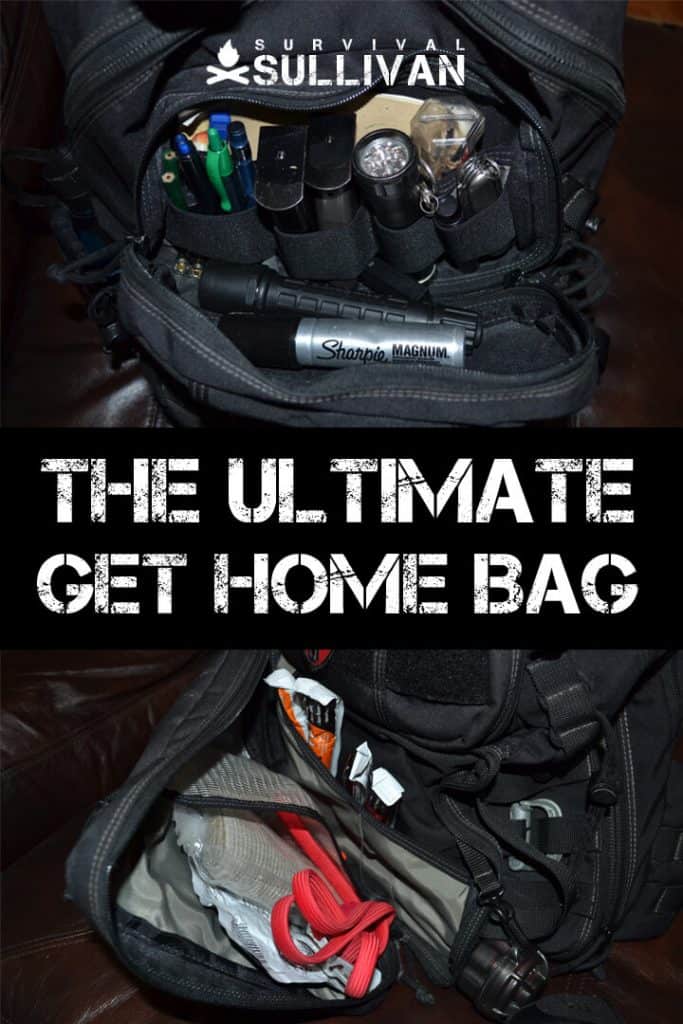

My dad was military. My grandfather was a cop. They served their country well. But I don’t like taking orders. I’m taking matters into my own hands so I’m not just preparing, I’m going to a friggin’ war to provide you the best of the best survival and preparedness content out there.

My concern about the possibility of an EMP is this: I’m a 60-year-old grandmother, with mobility issues, raising a 6-year-old granddaughter, who goes to school about 3 1/2 miles from home. I recently had a hip replaced and I’m coming up on back surgery. I do not own a mobility scooter. I do not believe the school has alternate plans in place to transport children home in the event of an EMP. How will I get my granddaughter home? I cannot walk to the school let alone back home again. I won’t be able to communicate with them or call a family member to see if they could go and get her. I am really trying to have this one emergency plan in place “just in case”. Lastly, all of my close-by family lives at least ten miles further from our grade school than I do. Advice is appreciated.
Your granddaughter needs to learn how to walk home by her self, 3 1/2 miles is not far. Are there other children she could walk with?
The easy answer is…ride a bike. I don’t get why this is always overlooked. No circuitry. No fuel. No complications. Outfit it with a rear tire stand that she can sit on and bada bing bada boom, you’re there and back in less than an hour. If you spin regularly like me…25-30 minutes.
Check out an adult tricycle. They come in several different styles, from the upright “Laundry Basket” type to the recumbents with either one wheel in front and two in back or with two in front and one in back. They also make trailers that hook onto the back of bikes and trikes for carrying kids, pets or cargo.
We were concerned about getting from our home in one state to our retreat in another in case of an EMP or other emergency that might prevent making the trip by car, so we bought two trikes, a trailer for the dog, another for cargo and racks for transporting the trikes by vehicle.
The advantage of a trike at my age (mid to late 60’s) is that balancing one is not an issue since they have 3 points of contact with the ground. They feel much safer and more stable than a bicycle.
They are also a good excuse to get some exercise when not in the midst of an emergency.
is it true (like One Second After says) that most cars won’t run? I am a 69 year old grandmother. My 12 yr old granddaughter and 19 yr old grandson live with me. the 12 yr old will most likely be at school, 4 miles away, and the grandson at school 11 miles away. How am I going to get them home?
@Linda Watson most newer cars won’t run as they rely on circuitry to operate and since your car will act like antennae to EMP fields the circuitry which is unprotected from EMP will be fried. Older model cars such as those made in the mid 90’s to early 2000’s will experience some damage but since most of them rely on mechanical means to operate will still run. You just may lose your speedometer or digital mileage readout. Cars built early 90’s and older will suffer no damage at all unless they’ve been somewhat modernized (like perhaps a fancy touchscreen radio). They’ll shut off but all they will need is a simple restart.
Contrary to popular myth, EMP does not fry everything. Handheld devices such as cellphones will still work as long as they are not plugged in. Cables will act as antennae to EMP emmissions so keep that in mind. If it has cables or is rather large like a desktop, it’ll be fried. That means cell towers will go. so even if your cell works it’ll just be a paperweight UNLESS you have some useful offline apps. I’d suggest getting those such as offline maps of your area, medical guides, etc. Addresses that perhaps you normally keep on the cloud should be downloaded as well.
If you want 100% guarantee you’ll have useful electronics still working such as a laptop or tablet, build a farads cage. You can do this with a cardboard box. Put some nonconductI’ve padding inside, put your electronics in (id wrap them so they don’t scratch themselves bumping around of you take it on the road. Next close it up and seal it with nonconductive tape and wrap it with a few layers of tin foil. The tin foil will absorb EMP emissions and keep the contents safe. Alternatively if you have say a HAM radio and desktop or any larger appliances you want safe you can turn a room into a giant faraday cage. I’d Google that as thats just a tad bit more complicated but still easy.
Note, after an EMP society will pretty much cave in. You’ll have rioters, looters, and those that just want to hurt people for thrills. Going to get your kids will be pointless if you don’t have anywhere safe to go because after all if you live in a decent house looters and what not will likely target it as soke place that’ll have something of value. I’d start with fortifying your house. Reinforce your doors with longer screws in the hinges and and kick plate (the part that your door latch connects to. Alternative and probaby a better solution is the door devil. If you got the money, there are companies that make security doors that you can buy that will prevent the common looter from breaking in without specialized tools like explosives are cutters. Some sell bulletproof doors. These will likely cost a few grand but I’d say worth it if you have the money. They’d be good for front and back doors or/and to make a saferoom. You’ll also need to reinforce your windows in some manner. Looters will stop at nothing to get in. While bars over the windows wouod detour most home invaders or robbers, the looters will likely use a vehicle and chain to pull the bars off. So the best option would be to get away from glass and go for some thing like plexiglass, or make some form of shutters out of plexiglass.
Ok so now your home is reinforced (I’d be more worried about civil unrest more than an emp btw but reinforcing home security if you dot have a place outside the city to go to is a must). So what good is a reinforced home if you don’t have the capability to sustain your self? Tie to stock up on food and water. For an EMP it really depends on how bad the attack was. It can take weeks or even up to a year or longer for some the grid to be restored in some capacity. Also note that during such an emp attack the military will likely enforce martial law the moment they get back on the feet which wont be long. They are better prepared than we are when it comes to such attacks. However, use Katrina as a guideline. It took months for any Federal entity to even begin to try and adminOster aid and try and restore order. And that was just one area of the US. So it will be much longer for them to mobilize in a National crisis such as an EMP. With that said, for an EMP I recommend storing enough food and water to feed your family for a year. I’d recommend canned, freeze-dried, or dehydrated food or even MRE’s. Keep in mind tho that freeze dried and dehydrated good takes water to prepare so if you go that route you’ll need water supply just for cooking. Also important to stock up on are first aid supplies. You should have a small kit for each family member and I’d recommend at least one or two trauma kits (might want to take some training too). There are some large medkit that will include a bit of everything. They’re pricey but they’ll be worth it. You also want emergency candles, flashlights, spare batteries, and a radio. I’d suggest a HAM radio as well. Dont need a license for monitoring and bugger all, license wont matter after an EMP. Granted, the license isn’t that hard to obtain. Also, you’ll need something for self defense. I recommend a shotgun for the house and perhaps a handgun for on the go (again during a crisis screw legality, but while we are currently fine, keep in mind carrying requires a license). Take training if you’ve never had guns before or at least never shot before. I’d also recommend some tactical and hand-to-hand training so you can fight through all the hooligans on the way to pick up your kids and get em home safely.
Lastly for your preparing, have a plan. When the big bang happens regardless of what kind it is, know how you will go get your kids. What route will you take? Is there a route you’d think would be safer to use? Quicker? What about alternate routes in case you have to detour? What will you do before the big bang? After? During? What if you have to abandon your house? Where would you go then and hiw would you get there? Speaking of which, for each member I’d pack what’s called a go bag. This pack should be light and be able to sustain each member indefinitely or 3 days at a minimum (this is where learning how to scavenge and hunt for food will come in handy if you run out of food on your way to safety). Now when the emp falls, enact that plan of yours.
Whats a Fardad cage, any links?
Faraday cage is a sealed metal container that keeps radio frequencies from getting in (or out). It can be as simple as an Altoids tin with metal tape around the seam. Other possible containers: metal garbage can with lid, cardboard on inside bottom and sides to prevent contact with metal. Again, sealed with metal tape.
Great example of a faraday cage is your Microwave! It keeps all the microwaves INSIDE of it while cooking your food! When you’re not using it, you CAN keep essential electronics in it (or a junk one) and have an excellent Faraday Cage.
Bicycles are a good option. Used cheap bicycles can be found on craigslist in you area.
Just my 2 cents, for you mobility issues. An adult tricycle, place for small ones and stable for balance impaired. The way over the top is to have a a small gas or battery motor that can “assist” with peddling. This means it would need to be protected from EMP energy prior to the event. You would be the envy of the neighborhood after an EMP event, even w/o the motor:).
Good luck.
Dee
Bicycles are a good option. I got one with a Motor with it (Phatmoto) but I found that due to my disability affecting balance, I needed a stabilizer. So, I bought a side car. That side care also provides a storage device for shopping and a complete home in a bag (cot tent), including the Bugout bag. Then I noticed that I could place a Wheel Hub Motor on the side car in case I ran out of fuel. I also found out I could pull a trailer as well and have little effect on speed. And I thought, perhaps I should place a solar power generator on the trailer with a collapsible Solar panel. Did you know you can also place wheel hub motors on the trailer to assist you maintain speed as well… especially with heavy loads. And lastly If you build your own Trailer, you could actually make that into a bolt on Teardrop trailer… That is when those wheel hub motors become really beneficial.
In regards to the above, I had a back injury and some of those concerns are mine too. I think we all should think of our personal needs, for myself and my husband who broke his back and wont be able to haul big loads on it…we have planned by having good old pioneer things like this site also offers up as info. I have a few large dogs and I have harnesses, dogs and many animals were used to haul by means of a wagon or small cart. For someone with a wheelchair a wheeled conveyance that can be aided by a pet, or just by your hands, manual transportation, horses etc.
Even with cell phones, someone had to be on the other end. so planning manual things may be the only choice, EMP wise.
Thanks for posting some good articles, I have only been here a few months and would love to see more like this that are updated as they are important and GAIN relevance rather than become outdated as things become more and more socially tense, political climates are unsteady, resources becoming scarce…etc.
Plus we can see new products if they apply and would help…like the new lighweight fabrics, Tac lights, etc
Thanks for supplying such a valuable resource, there is so much WRONG info as people fill sites and just recopy things already out there…well, its refreshing to see actual pictures and myths busted, and people that actually DO these things and/or research the info.
I really like Ryan’s series, and we are building a chicken flock and really I didnt know I DIDNT need a rooster, and I saw excellent RELATED articles on caring and getting more eggs. I like Jack’s book, and always grab some hot Tea to read Dans and usually print the lists like this one. I am biased about Dyann and Eric, as I know them and even got to help make doggie treats as we made Pet BOB’s haha Meghan has really great reads and really liking Heath pieces too. This is my daily morning reading, so thanks again for providing a site where I dont have to go anywhere else and wonder if its just the same paid content or someone who cares, and takes the time to cover all the bases.
Thank you for the kind words and I’ll do my best to deliver daily articles to you and everyone else. I feel humbled to have such a kick-ass team of experienced writers who are the real deal! 🙂
Roosters leave rooster ? bullets in your eggs won’t hurt nothing ? but you can’t restock from your own flock you have to buy out side replacements by raising your own you can have a young rooster in the pot now and then
For you that have a little land you can build an earth ship from old tires and dirt covered store your supplies and water with a composting toilet inside ? plant different types of garden foods learn to can by using outside facilities
Shorty
Shorty: since when can’t you restock from your own flock? What you do is cull, cull, cull both roosters AND hens to upgrade whatever traits you want. This is how new breeds of livestock are developed; the other way is to crossbreed and cull, cull, cull to stabilize the traits you want. This works for both animals and plants.
I really like the comments on “older” folks, and those who are “challenged” as far as their mobility – I’m 71 and not in best shape, have arthritis in feet, cant walk far, and so on. Probably couldnt do a leg kick if life depended on it! LOL…anyway, suggestions are great, please keep’em coming! best of luck out there, be safe and well.. getting concerned about situations out there too…have stocked things as suggested, ammo etc., but each time I read this stuff, I realize how vulnerable we are, as are others too. but at least I can prepare, I’ll just shoot anyone that breaks in…
I think Laptop Bag are not a good idea.. looks valuable for criminal.. how about sports bag with a towel/ shirts on top to hide the contents?
So what caught my eye in your photo was the Sharpie. Yet no explanation unless you are using it as your writing device. Do you have it for other uses? It seems large if all you would need is a pencil.
Hey John,
You can use a sharpie to write on duct tape, for instance. But if all you think you’ll need is a pencil, then by all means go for it.
Dan